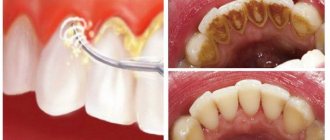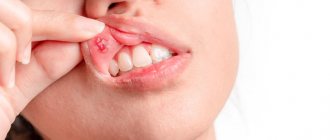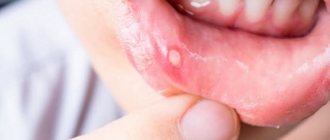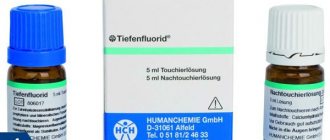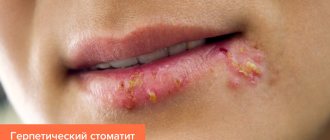Have questions?
Herpetic or herpes stomatitis is an inflammation of the oral mucosa caused by the herpes simplex virus. The disease manifests itself as ulcers in the mouth, headache and even fever.
This type of stomatitis accounts for about 80% of all infectious lesions of the oral cavity. The infection mainly develops in children's bodies, and children under three years of age are most susceptible to it. HIV carriers, diabetics, patients with chronic pathologies and people with weakened immune systems are also at risk.
Clinical manifestations
Symptoms of herpetic stomatitis vary depending on the form and stage of progression of the disease. Common signs of a viral infection include:
- swelling of the cervical and submandibular lymph nodes;
- jump in body temperature;
- blisters on the mucous membrane of the cheeks, tongue, palate, which are damaged and turn into bleeding ulcers and erosive formations;
- discomfort, pain, burning, itching in the mouth;
- weakness, migraine.
In adults, viral herpetic stomatitis is more complicated. At the same time, a severe form of the disease often develops in people who had an acute stage of the disease in childhood, and at the moment their body is weakened due to severe hypothermia, blood disease, cancer, etc.
Causes
Herpetic stomatitis, or as it is also called aphthous stomatitis, is dangerous, first of all, for young children. It is a serious viral disease, which, in addition to damaging the oral mucosa, causes general intoxication of the body and provokes malfunctions of the nervous, immune, and reticuloendothelial systems.
Herpes, which is the causative agent of the disease, may not make itself felt for a long time, although infection usually occurs in early childhood.
When the baby’s immunity is weakened, the herpes virus is activated and begins to multiply, causing an increase in temperature, enlargement of the submandibular lymph nodes, acute inflammation of the mucous membrane, and the formation of bleeding and painful ulcers on its surface.
Main reasons:
- decreased baby's immunity;
- previous infectious diseases;
- lack of vitamins;
- insufficient oral hygiene;
- direct contact with patients with herpes stomatitis.
Infants are more likely to become infected with the herpes virus during childbirth, provided the mother has a herpes infection. In children under one year old and school-age children, the virus is activated against the background of an organism weakened by disease and vitamin deficiency.
Classification of the disease
Before starting treatment for herpes stomatitis, it is necessary to determine the form and degree of its progression. At the same time, acute herpetic stomatitis in children is diagnosed already when the virus first enters the body.
The severity of the disease is divided into:
- Light. Small blisters form on the oral mucosa - they quickly disappear after they rupture;
- Average. The rashes are more extensive, body temperature rises (up to 38º);
- Heavy. The patient has an abundance of ulcers in his mouth, and after they disappear, new ones appear. Symptoms are supplemented by fever, headache and chills, sometimes the patient feels sick and has diarrhea.
In the absence of proper treatment, chronic recurrent herpetic stomatitis develops. This form of the disease is already characterized by group rashes (on the inside of the cheeks, tongue and palate). The formations combine and form painful erosions. In the recurrent stage, except for rashes, no other symptoms of the disease are noted. The disease may return 2-6 months after treatment.
Herpetic stomatitis - symptoms and treatment
Treatment of patients with mild and moderate forms of the disease is carried out on an outpatient basis, i.e. at home, but with regular visits to the doctor. Patients with severe forms of stomatitis, complications and generalized forms of the disease - when the virus affects the entire body - are subject to hospitalization. Treatment includes adherence to the regimen, diet, local and general therapy [5].
All patients require gentle treatment . If the child is lying down, he needs to be provided with fresh air and regular changes of linen. If he plays and refuses to go to bed, there is no need to put him to bed by force - it is better to occupy him with quiet games, reading, etc. You should not go with a sick child to kindergarten, school, shops, shopping centers, cinemas, playgrounds. It must be remembered that the disease is very contagious, and other children can become infected. But during the recovery period, walks in the fresh air separately from other children are possible.
The room where the child is located must be ventilated 3-4 times a day, daily wet cleaning is necessary. The child also needs more sleep. But if he sleeps almost all day and has difficulty waking up or, on the contrary, hardly sleeps, then an additional examination by a doctor is required.
But refusing to eat is not so bad. Eating becomes very painful, so you should not insist, much less force-feed the child. It is worth offering liquid food, porridge, jelly, pureed soups.
It is important to prevent dehydration . Small febrile children become dehydrated very quickly, this increases intoxication and aggravates the condition. Therefore, it is necessary to give the child plenty of water. It is worth offering any liquids: water, compote, tea, diluted juices without sugar. The amount of liquid you drink should be at least 1.5-2 liters. If there is vomiting or the child refuses to drink, you need to give him a teaspoon every 5-7 minutes.
Pain relief also plays an important role . At the height of the disease, patients experience severe headaches and mouth pain. For pain relief, paracetamol and ibuprofen are most often used. The dose is calculated depending on body weight, drugs can be alternated.
Fever above 38.5℃ in young children, in children with a history of febrile seizures or with poor tolerance should be brought down. Fever above 39.5℃ should be reduced in all patients. If, when taking an antipyretic drug, the temperature drops by at least a degree, this is good, but if it does not decrease or rises even higher, then an additional examination by a doctor is required.
With mild severity, it is quite possible to get by with local treatment . This requires careful oral hygiene, rinsing or treatment with antiseptic solutions that do not contain alcohol: furatsilin 1:5000, 2% aqueous solution of chlorhexidine, etc. Acyclovir ointment is used to treat aphthae - 3% for mucous membranes, 5% for skin . From about the third day of illness, healing agents based on an oil solution of vitamin A, sea buckthorn oil, aekol, and solcoseryl are added. Local treatment is carried out 5-6 times a day until the lesions are completely healed.
IMPORTANT : the use of local anesthetics based on lidocaine is not recommended for children under 12 years of age [5]. The use of local aerosol antiseptics for acute herpetic stomatitis is also undesirable.
For moderate forms, local treatment alone is not enough. General antiviral treatment is added . For this purpose, acyclovir and valacyclovir (Valtrex) are used in children. The first drug is used in an age-specific dosage 5 times a day - this is important . Valtrex is used 2 times a day, which is more convenient.
IMPORTANT : interferon preparations (viferon, genferon, cycloferon), as well as homeopathic antiviral agents (anaferon, aflubin) and immunomodulators (imudon, thymogen, lykopid) are not indicated, since their effectiveness and safety in the treatment of infections caused by herpes viruses has not been proven .
Recurrent forms require additional examination by a doctor and the appointment of a prolonged course of antiviral treatment.
Severe and complicated forms of the disease are treated in a specialized hospital, since outpatient treatment will be ineffective [1][2]. It involves taking antiviral drugs in the form of tablets and injections, detoxification therapy, replenishment of lost fluid and electrolytes, and intravenous supply of necessary solutions [11].
It is worth remembering that acute herpetic stomatitis is a disease caused by a virus. Therefore, in routine cases, antibiotics are not required , even if the fever lasts more than three days - this is a typical condition for the disease.
How to treat herpetic stomatitis?
Treatment of herpetic stomatitis in children and adults can be general or local. The therapeutic treatment strategy is determined by the form and severity of the disease. In this case, the patient is usually shown:
- high-calorie diet, drinking plenty of fluids, bed rest;
- antiviral drugs (orally, intravenously or intramuscularly);
- restorative therapy (taking vitamins);
- symptomatic treatment (use of antipyretics, painkillers, anti-inflammatory drugs);
- local therapy (rinses, applications, etc.).
When choosing tactics for treating acute or chronic herpetic stomatitis in adults and children, it is important to correctly determine the form and stage of the disease. That is why experts urge patients not to self-medicate, but to immediately consult a doctor if signs of damage appear.
Therapy under the supervision of a specialist will allow you to recover quickly and without consequences for the body. With the right approach, herpes stomatitis in a child or adult can be cured in 10-14 days.
Acute herpetic stomatitis in children and adults: treatment
When herpetic stomatitis is detected in adults and children, it is possible to determine how and how to treat this disease only after differential diagnosis: the herpetic and aphthous types are very similar in symptoms, but the drugs used for therapy are completely different. Therefore, first of all, you need to do tests and make sure that the cause of the disease was the herpes virus.
When treating the disease, antiviral drugs, immunomodulators (to stimulate the immune system), local antiseptic treatments, and vitamin complexes are used to maintain the body's defenses. Additionally, symptomatic medications are used: painkillers, antipyretics for high body temperature in children (above 38.5 degrees).
The doctor prescribes all medications and treatment regimens individually, taking into account the patient’s age, the general condition of his body, the severity of the disease and its form (acute or chronic). In addition, proper dental care is also important - both during and after treatment. The doctor will give all the necessary recommendations for care and help you choose hygiene products individually.
Herpetic stomatitis during pregnancy requires a special approach. In addition to local treatment with antiseptics, it also requires antiviral therapy, but the doctor selects the drugs very carefully, taking into account the possible risks for the pregnant woman and the fetus. Treating yourself in this situation is extremely risky; self-medication can cause serious complications in the body of the mother and her unborn child.
“32 Dent” clinics provide all types of dental services, including gum treatment. Dentists are equipped with the latest equipment, and doctors have extensive experience working with a variety of, even the most complex, clinical cases. By contacting us, you receive high-quality treatment and lasting results at an affordable price.
Sources:
- Personal experience as a dentist;
- Danilevsky N.F., Leontyev V.K., Nesin A.F., Rakhniy Zh.I. Diseases of the oral mucosa. - M.: OJSC "Dentistry", 2001;
- Ivanova E.N. and others. Diseases of the oral mucosa. - Rostov n/d.: Phoenix, 2007;
- Ed. prof. A.L. Mashkilleyson, prof. E.V. Borovsky. Diseases of the mucous membrane of the oral cavity and lips. - M.: MEDpress, 2001;
- Kolesov A.A. Pediatric dentistry. M.: Medicine, 1991;
- Vinogradova T.F., Maksimova O.P., Melnichenko E.M. Periodontal disease and oral mucosa in children. M.: Medicine, 1983;
- Whitley RJ, Roizman B. Herpes Simplex virus Infection // The Lancet. 2001.
Examination for herpetic stomatitis
The diagnosis is made based on the clinical manifestations of the disease and the results of laboratory tests. Identification of the virus is carried out by studying blood serum, scrapings from the oral mucosa, and saliva. Sometimes serological tests (ELISA) and PCR are necessary. Herpetic stomatitis requires differentiation from other types of stomatitis, tonsillitis, measles, scarlet fever, gingivitis and other diseases with similar clinical symptoms.
Chronic stomatitis
Symptoms of chronic stomatitis
Chronic recurrent aphthous stomatitis
Clinical signs of this type of stomatitis usually appear during its exacerbation.
Namely, one or two aphthae are formed on the oral mucosa, which are sensitive and painful. Aphtha is a small necrotic lesion on the mucosa, which externally looks like an oval formation with a diameter of up to 10 mm. The area around the aphthae has a bright red tint and is covered with a white fibrinous coating. This focus of necrosis can exist for about two weeks. Typically, the plaque surrounding the aphthae disappears after six days, and the aphthae itself heals within three days. A small red spot appears at the site of the outbreak. In most cases, aphtha is located on the inner surface of the cheeks, the mucous membrane of the lips, under the tongue, on the gums and soft palate.
Between periods of exacerbation, patients are usually diagnosed with long-term remissions, which sometimes last even several years. When an exacerbation of the disease occurs again, it is indicated only by the appearance of foci of necrosis. The general health of the patient usually remains the same. In rare cases, patients complain of fever, weakness, and bad mood.
Chronic ulcerative-necrotic stomatitis of Vincent
This type of chronic stomatitis is most often found in young men aged 17-30 years. The peak of exacerbation of the disease usually occurs in autumn and spring. The first manifestations of the disease are bleeding gums, pain in the mouth, general weakness, and bad breath. Due to intoxication, the patient appears pale. The necrotic process is usually localized on the gum, but then it affects other areas of the oral mucosa.
If necrosis reaches the buccal mucosa, the patient experiences pain and trismus (spasm of the masticatory muscles) when swallowing. In the most difficult cases, facial asymmetry may even occur due to swelling of the surrounding tissue necrosis. The patient’s general condition rapidly deteriorates: the body temperature suddenly rises, headache, weakness, and fainting appear.
Chronic herpetic stomatitis
Signs of herpetic stomatitis usually appear due to overheating, hypothermia, psycho-emotional or physical fatigue. This type of stomatitis is characterized by the constancy of the localization of the rash. If for the first time the rash appeared in the eyes, in the mouth or genitals, then there is a possibility that during a relapse the lesion will appear in the same area.
The most specific signs of the disease are hyperemia of the affected area of the mucosa, the formation of single or multiple blisters, which after opening form erosions, the absence of tissue infiltration, bad breath and severe bleeding. During periods of exacerbation of the disease, patients experience a significant deterioration in general health, loss of appetite, irritability, fatigue, and joint pain. During subsequent relapses, symptoms become less severe.
If a patient is diagnosed with a mild form of the disease, then he experiences an exacerbation twice a year. Small, inflamed areas are found in patients' mouths. The moderate form of the pathology is characterized by relapses no more than four times a year. In patients with a severe form of the herpetic type of disease, relapses appear up to six times a year and are accompanied by the formation of new lesions, headache, and poor appetite.
Chronic denture stomatitis
Denture stomatitis is diagnosed in 50% of patients who use removable dentures. With this type of disease, inflammation affects the area of the mucosa that is in direct contact with the prosthesis. During the examination of the patient, the doctor discovers hyperemia of the prosthetic bed, local bleeding of the gums, and decubital ulcers. Often, due to injury to the mucous membrane, patients develop papillomas and hyperplasia.
Chronic stomatitis of smokers
In most cases, this type of stomatitis is diagnosed in middle-aged men who smoke for a long time. In long-term smokers, the oral mucosa acquires a bluish-brown tint, becomes covered with a white coating, and over time, hyperkeratosis of the palate also develops. It has been proven that smokers with stomatitis are at risk of developing oral cancer.
Classification and diagnosis
Herpetic stomatitis is classified both according to the severity of the disease and the characteristics of its course.
According to the characteristics of the course, acute and chronic (recurrent) forms are distinguished. Acute stomatitis is characterized by a sudden onset, pronounced symptoms, and rapid development. Without proper treatment, it quickly becomes chronic and can drag on for years, periodically exacerbating.
Based on the degree of severity, there are mild, moderate, and severe forms.
In mild forms, the following are noted:
- slight increase in body temperature;
- redness, swelling, inflammation of the gums;
- swollen lymph nodes;
- a small number of painful ulcers.
The average degree is characterized by:
- significant increase in body temperature;
- general weakness, nausea, headache;
- inflammation of the oral mucosa;
- the appearance of a blistering rash on the inner surface of the cheeks, gums, tongue, and around the mouth.
The severe form causes:
- temperature rise to a critical level;
- lymphadenitis of the cervical, submandibular lymph nodes;
- a sharp disturbance in general well-being;
- the appearance of severe muscle pain, headache;
- nausea, vomiting;
- multiple rashes that spread to the eyelids, conjunctiva, and perioral area.
Diagnosing the disease is not difficult for an experienced doctor. It is based on an analysis of the main symptoms, the order of clinical manifestations of the disease, the nature, and multiplicity of ulcers.
It is necessary to differentiate herpetic stomatitis from viral stomatitis; for this, in the first few days of the disease, a cytological examination of scrapings from erosions and aphthae should be done.
How long does the disease last and how many days is the child contagious?
Depending on the complexity of the form, herpes stomatitis in children lasts from several days to 2-3 weeks. With a mild form, the main symptoms disappear on the third or fourth day, treatment of a moderate form takes one to two weeks. The severe form is the most dangerous; healing lasts for weeks and requires mandatory hospitalization of the baby.
The disease is characterized by a high degree of contagiousness precisely during the period of exacerbation.
The infection is transmitted by airborne droplets (including through kissing), when using shared dishes, cutlery, toys, and hygiene items.
Herpes is contagious and can easily be transferred to healthy parts of your own body.
It is necessary to wash your hands thoroughly after treating the surface affected by the sores with medications to prevent the spread of the virus.

